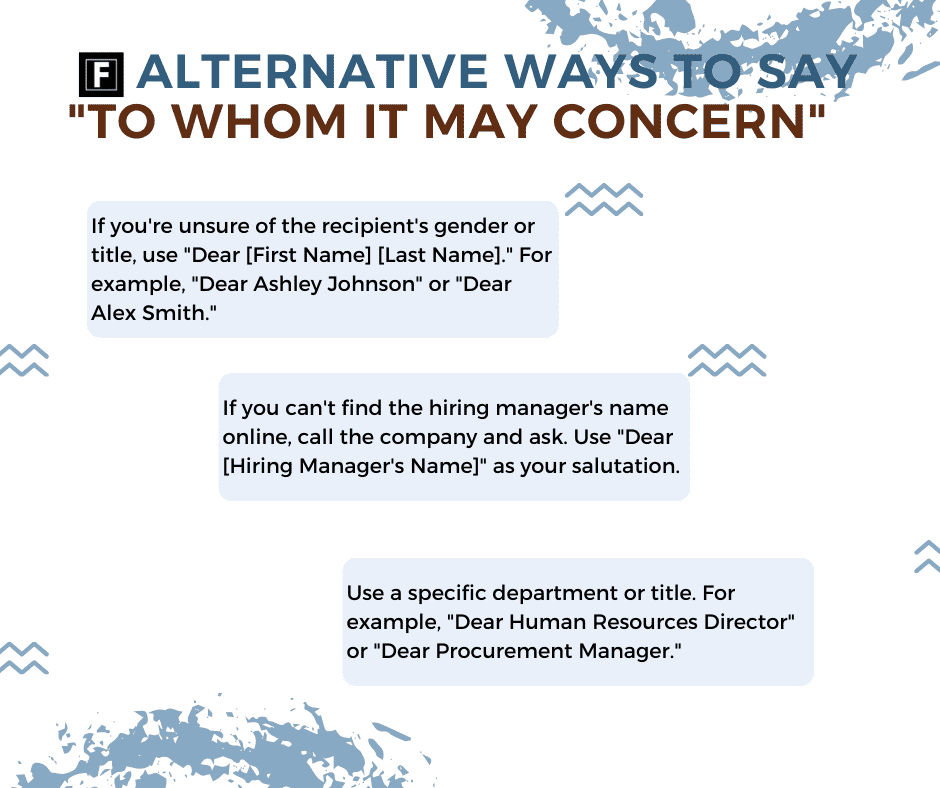When it comes to addressing someone in a formal letter or email, the phrase “To Whom It May Concern” is often used. This generic salutation is commonly employed when the writer doesn’t have a specific recipient in mind or is unsure about the appropriate person to address. While “To Whom It May Concern” has been a longstanding convention, it is worth considering its advantages and disadvantages.
|
Features |
Pros |
Cons |
Differences |
|---|---|---|---|
|
Formality |
– Suitable for professional correspondence. – Maintains a respectful tone. |
– Can come across as impersonal. – Lacks personalization. |
“To Whom It May Concern” is a formal salutation that is commonly used in business or professional settings. |
|
Flexibility |
– Can be used when the recipient’s identity is unknown. – Appropriate for general inquiries or requests. |
– It may seem generic or unengaging. – Might give the impression of laziness or lack of effort. |
The phrase allows for flexibility when the writer is unsure about the specific recipient. |
|
Widely Accepted |
– Recognized as a conventional salutation. – Commonly used in various industries. |
– Can be seen as outdated or old-fashioned. – May not resonate with younger generations. |
“To Whom It May Concern” is a widely accepted and understood phrase in professional communication. |
While “To Whom It May Concern” offers formality and flexibility, it can also be seen as impersonal and generic. However, it remains a widely accepted convention in professional correspondence. When using this salutation, it is essential to consider the context and the recipient’s expectations. If possible, it is always preferable to address the letter or email to a specific individual. This demonstrates effort, personalization, and a genuine interest in engaging with the recipient.
However, it is important to consider the potential drawbacks, such as the lack of personalization and the possibility of appearing generic. By understanding the context and using the salutation judiciously, writers can effectively navigate the complexities of addressing unknown recipients in their correspondence.
When and Why to Use “To Whom It May Concern”
To Whom It May Concern” is a phrase that is commonly used in letters and emails when the recipient’s name is unknown. It serves as a generic greeting and has been a popular choice for formal communication. However, the usage of “To Whom It May Concern” has raised concerns among people who feel that it is outdated and impersonal. While it is true that it may not be the best choice for all situations, there are instances when it is still appropriate and necessary.
When to Use This Generic Salutation
When writing a cover letter for a job application, “To Whom It May Concern” can be used as a last resort when you cannot find the name of the hiring manager.
In official letters to government organizations or companies, “To Whom It May Concern” can be used to address a particular department or division that is responsible for handling the matter at hand.
When writing a recommendation letter, “To Whom It May Concern” can be used if you do not know the recipient’s name or if the letter would be addressed to multiple parties.
In situations where the recipient’s name is unknown, and you need to convey an urgent or important message, “To Whom It May Concern” can be a suitable choice.
Why Should be Used
It is a neutral and professional way to address a recipient whose name is unknown. So, It can be used as a polite and respectful way to address a department or division responsible for handling a matter.
Moreover, It can save time and effort in trying to find the recipient’s name.
While “To Whom It May Concern” may not be the most personal or effective way to address a recipient, it is still a valid option in certain situations. The key is to use it appropriately and avoid overusing it. When possible, it is recommended to make an effort to find out the recipient’s name and address them directly to establish a more personal connection.
Suggestions: While searching for attractive job opportunities, you must consider work-from-home jobs as well (detail is here).
Effective Introductions in Business Communication
Everyone wants to be known for their professional presence, especially in business communication. Crafting an effective introduction is an art – one that requires finesse and proper usage of appropriate language.
To Whom It May Concern: is a common starter phrase used at the beginning of a letter or email when addressing someone whom you may not know or whom you need to reach out to on official matters.
Indeed, using these three iconic words can make your letter sound more professional and respectful, even if you’re unsure with whom this correspondence is being sent. But there’s more information than just that! Engaging introductions will be an important part of effective business conversations; this blog looks closely into the age-old saying ‘To Whom it May Concern” uniquely, as well as other techniques for effectively introducing yourself in writing—all without appearing stuffy or overly formal (unless situations call for such).
We begin by looking at how best to properly use “To Whom It May Concern” before moving on to addressing colleagues from different cultural backgrounds and practical tips & insightsfor crafting welcoming introductions depending upon the situation context.
Features of Effective Introductions in Business Communication
|
Features |
Pros |
Cons |
|---|---|---|
|
Clear and concise |
– Grabs the reader’s attention quickly – Provides a clear overview of the main points |
– May lack in-depth information |
|
Engaging and interesting |
– Keeps the reader interested – Makes the communication memorable |
– Requires creativity and effort in writing |
|
Relevant and tailored |
– Addresses the specific needs and interests of the audience – Increases the chances of a positive response |
– Requires research and understanding of the audience |
|
Sets the tone |
– Establishes a professional and credible image – Builds trust and rapport with the audience |
– May limit flexibility in communication style |
Understanding Diversity and Modern Society in Communication
Writing effective communication is essential for successful interactions in our modern society. No matter how gifted an individual might be, if they don’t know how to communicate clearly and effectively, then the transfer of ideas gets lost in translation.
On top of this complexity, understanding diversity often presents itself during conversations, complicating a clear transmission can happen with anyone from different backgrounds who is using new forms of communicative platforms such as social media or group chats.
Diversity has made it more challenging to achieve understanding within communication as we may take into account people’s ideologies, cultural backgrounds, and opinions, which require specific qualities to communicate with each other respectably.
Furthermore, learning about diversity gives us a state-of-the-art opportunity to feel connected internationally through representational equality that is accessible across borders, geographical origins, religious affiliations, languages, female-male nonbinary.. etc.
Thus enabling the development of enlightened dialogue furthermore grounded on global platforms social activism targeting change towards broader topics issues such migration, public policy, human rights, economy entertainment, sports, celebrities trade, international Intel opportunities, careers, social entrepreneurship, revolutionary catalytic powers ..etc. takes place today at stages.
Alternative Ways to Say “To Whom It May Concern”
To Whom It May Concern” is a common salutation used in formal documents and letters. However, using this phrase repeatedly can make your writing seem stale and impersonal. Here are some alternative ways to address your reader:
- If you know the name of the person you’re writing to, use it. It will make your correspondence feel more personal and professional. But, If you’re unsure of the recipient’s gender or title, use “Dear [First Name] [Last Name].” For example, “Dear Ashley Johnson” or “Dear Alex Smith.”
- If you’re applying for a job, use the hiring manager’s name. It will show that you’ve done your research and are genuinely interested in the position. Somehow, If you can’t find the hiring manager’s name online, call the company and ask. Use “Dear [Hiring Manager’s Name]” as your salutation.
- If you’re writing a business letter, use a specific department or title. For example, “Dear Human Resources Director” or “Dear Procurement Manager.” This will show that you’re taking the time to address your letter to the right person and department.
Using alternative salutations can help you stand out from the crowd and make a positive impression on your reader. “To Whom It May Concern” may be a safe choice, but it won’t help you form any lasting connections with your audience. So, take the time to do your research and address your reader in a personal and professional manner.
Examples and Usage of “To Whom It May Concern”
When writing a formal letter or email, it can be tricky to figure out how to address your recipient, especially when you do not know their name or their specific role in an organization. This is where the opening phrase “To Whom It May Concern” comes into play. This phrase is commonly used in formal communication when the recipient’s identity is unknown.
It is a polite and professional way to open a letter or email. It can be used in a variety of situations, such as when applying for a job or contacting a company for information.
To Whom It May Concern is particularly useful in professional communication, such as when reaching out to companies, organizations, or government bodies. This opening phrase is neutral and respectful, and it does not assume anything about the recipient’s gender, title, or cultural background.
By using this phrase, you show that you are aware of the etiquette of formal communication and that you are willing to be courteous and professional. Additionally, you can use this phrase to maintain a level of formality throughout the communication, even if you later develop a relationship with the recipient and get to know them on a first-name basis.
Some examples of when to use To Whom It May Concern are:
- When sending a formal letter to a company or organization, either for business purposes or to make a complaint or inquiry.
- Secondly, when requesting information from a government body or an official institution, such as a university or hospital.
- Furthermore, when forwarding a document or proposal to an unknown recipient, such as when applying for a job or seeking funding for a project.
- Moreover, when addressing a group of people in a formal setting, such as a conference or a meeting.
Overall, To Whom It May Concern is a useful opening phrase that can be used in a variety of formal communication situations. By using this phrase, you can show that you respect the conventions of professional communication and that you are willing to engage with your recipients politely and professionally.
Frequently Asked Questions about “To Whom It May Concern”
What is the meaning of “To Whom It May Concern”?
The phrase “To Whom It May Concern” is a salutation used when addressing a letter or other communication without having a specific recipient in mind. It is often used when writing letters of recommendation, job applications, and other formal documents.
When should I use the phrase “To Whom It May Concern”?
The phrase “To Whom It May Concern” should be used when you do not know the name of the person who will be reading your letter or other communication. If you can identify the specific individual who will be receiving your correspondence, it is best to use their name in the salutation.
How do I address a letter that begins with “To Whom It May Concern”?
When addressing a letter that begins with “To Whom It May Concern,” it is important to be as clear and concise as possible. Be sure to include all relevant information, such as contact details, dates, and any other necessary information, so that the reader can easily understand what you are trying to communicate.
Is there an alternative to using “To Whom It May Concern”?
Yes, there are several alternatives to using “To Whom It May Concern” when addressing a letter or other communication without knowing who will be reading it. These include phrases such as “Dear Hiring Manager,” “Dear Recruiter,” or simply “Dear Sir/Madam.”
Conclusion: The Importance of “To Whom It May Concern”
As the old saying goes, “you only have one chance to make a first impression.” This sentiment couldn’t be more relevant than it is when it comes to the use of “To Whom It May Concern” in professional communication. Although it may seem like a generic and impersonal form of address, its importance cannot be understated. Not only does it provide a clear indication of who the message is intended for, but it also shows respect for the recipient’s time and position.
Whether you’re writing a cover letter or a business email, using “To Whom It May Concern” can set the tone for a successful and productive interaction. So, next time you’re drafting an important message, remember the power of these simple words and use them to your advantage.



